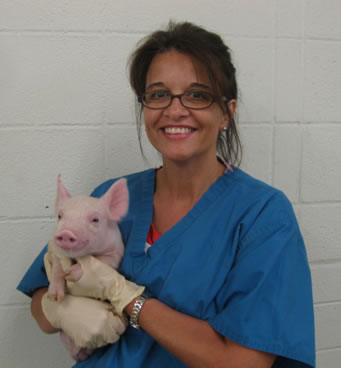Associate Research Professor
- PhD, University of Missouri, Department of Immunology and Molecular Biology
- BS, Saint Mary College, Leavenworth, KS

Building Address: Bond Life Sciences Center
Phone Number: 573-356-0343
Email: lorsonm@missouri.edu
RESEARCH INTERESTS
I have primarily focused my research efforts towards understanding how mutations in IGHMBP2 result in two distinct diseases SMARD1 and CMT2S. Towards understanding the role of IGHMBP2 in generating disease, we have generated six Ighmbp2 mouse models that are based on SMARD1 and CMT2S patient mutations. A manuscript detailing the initial characterization of one of these mutations, D564N, was published in 2022. Importantly, the D564N model was the first SMARD1 model published that has the defining clinical symptom of SMARD1, respiratory distress. We are also investigating modifiers of Ighmbp2 mutant phenotypes and in 2023 published the first modifier of SMARD1 pathology, ABT1. These mouse models, based on patient mutations, have provided a valuable resource that has greatly expanded our knowledge on the function of IGHMBP2 and how IGHMBP2 biochemical function relates to disease development and progression. Our goal is to use this knowledge towards developing-addressing therapeutic options including gene therapy alternatives and small molecules that alter IGHMBP2 biochemical activity.
SELECTED PUBLICATIONS
ABT1 modifies SMARD1 pathology via interactions with IGHMBP2 and stimulation of ATPase and helicase activity.
Vadla GP, Ricardez Hernandez SM, Mao J, Garro-Kacher MO, Lorson ZC, Rice RP, Hansen SA, Lorson CL, Singh K, Lorson MA. JCI Insight. 2023 Jan 24;8(2):e164608. doi: 10.1172/jci.insight.164608. PMID: 36480289
The Ighmbp2D564N mouse model is the first SMARD1 model to demonstrate respiratory defects.
Smith CE, Lorson MA, Ricardez Hernandez SM, Al Rawi Z, Mao J, Marquez J, Villalón E, Keilholz AN, Smith CL, Garro-Kacher MO, Morcos T, Davis DJ, Bryda EC, Nichols NL, Lorson CL. Hum Mol Genet. 2022 Apr 22;31(8):1293-1307. doi: 10.1093/hmg/ddab317. PMID: 34726235